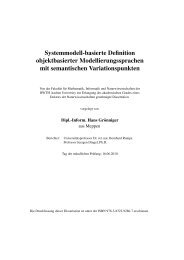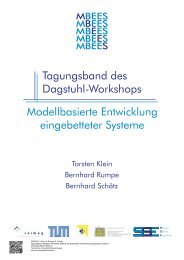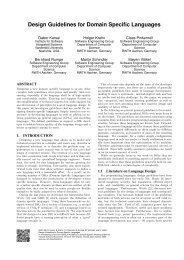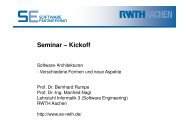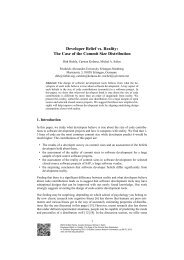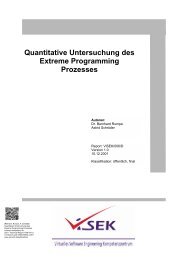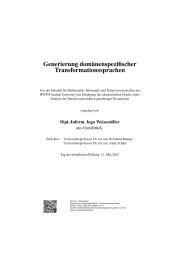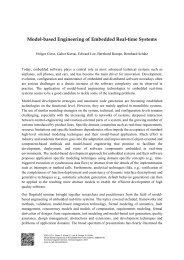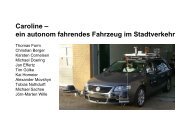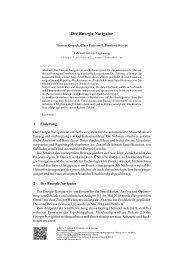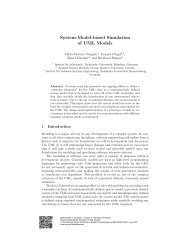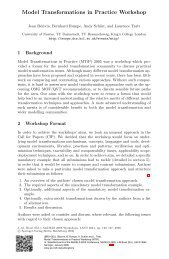Product Line Metrics for Legacy Software in Practice
Product Line Metrics for Legacy Software in Practice
Product Line Metrics for Legacy Software in Practice
Create successful ePaper yourself
Turn your PDF publications into a flip-book with our unique Google optimized e-Paper software.
<strong>Product</strong> <strong>L<strong>in</strong>e</strong> <strong>Metrics</strong> <strong>for</strong><br />
<strong>Legacy</strong> <strong>Software</strong> <strong>in</strong> <strong>Practice</strong><br />
Christian Berger, Holger Rendel, Bernhard Rumpe<br />
<strong>Software</strong> Eng<strong>in</strong>eer<strong>in</strong>g<br />
RWTH Aachen University<br />
Aachen, Germany<br />
http://www.se-rwth.de/<br />
Carsten Busse, Thorsten Jablonski, Fabian Wolf<br />
Electronics Development<br />
Volkswagen AG Bus<strong>in</strong>ess Unit Braunschweig<br />
Braunschweig, Germany<br />
http://www.volkswagen.de/<br />
Abstract—Nowadays, customer products like vehicles do not<br />
only conta<strong>in</strong> mechanical parts but also a highly complex software<br />
and their manufacturers have to offer many variants<br />
of technically very similar systems with sometimes only small<br />
differences <strong>in</strong> their behavior. The proper reuse of software<br />
artifacts which realize this behavior us<strong>in</strong>g a software product<br />
l<strong>in</strong>e is discussed <strong>in</strong> recent literature and appropriate methods<br />
and techniques <strong>for</strong> their management are proposed. However,<br />
establish<strong>in</strong>g a software product l<strong>in</strong>e <strong>for</strong> <strong>in</strong>tegrat<strong>in</strong>g already<br />
exist<strong>in</strong>g legacy software to reuse valuable resources <strong>for</strong> future<br />
similar products is very company-specific. In this paper, a method<br />
is outl<strong>in</strong>ed <strong>for</strong> evaluat<strong>in</strong>g objectively a legacy software’s potential<br />
to create a software product l<strong>in</strong>e. This method is applied to<br />
several development projects at Volkswagen AG Bus<strong>in</strong>ess Unit<br />
Braunschweig to evaluate the software product l<strong>in</strong>e potential <strong>for</strong><br />
steer<strong>in</strong>g systems.<br />
I. INTRODUCTION AND MOTIVATION<br />
In recent literature [1], concepts <strong>for</strong> creat<strong>in</strong>g a software<br />
product l<strong>in</strong>e are outl<strong>in</strong>ed which discuss either top-down<br />
methodologies <strong>in</strong> develop<strong>in</strong>g new products accord<strong>in</strong>g to a<br />
product l<strong>in</strong>e which is created from scratch, or bottom-up<br />
methodologies to refactor an exist<strong>in</strong>g software architecture<br />
towards a product l<strong>in</strong>e to serve similar products. However,<br />
guidel<strong>in</strong>es are miss<strong>in</strong>g on how to evaluate and select suitable<br />
parts of exist<strong>in</strong>g legacy software <strong>in</strong> a practical and economic<br />
way to create a software product l<strong>in</strong>e.<br />
There<strong>for</strong>e, <strong>in</strong> [2] several metrics are elaborated to evaluate<br />
objectively a set of exist<strong>in</strong>g software products to gather <strong>in</strong><strong>for</strong>mation<br />
about their exist<strong>in</strong>g potential <strong>for</strong> creat<strong>in</strong>g a software<br />
product l<strong>in</strong>e. In this paper, these metrics are applied at Volkswagen<br />
AG Bus<strong>in</strong>ess Unit Braunschweig <strong>for</strong> evaluat<strong>in</strong>g exist<strong>in</strong>g<br />
steer<strong>in</strong>g systems which are implemented <strong>in</strong> the Volkswagen<br />
Tiguan and Passat to estimate the benefit of creat<strong>in</strong>g a software<br />
product l<strong>in</strong>e. Because these steer<strong>in</strong>g systems are safety-critical,<br />
a proper reuse of exist<strong>in</strong>g artifacts is highly desirable whose<br />
elements have to be selected by rely<strong>in</strong>g on an objective<br />
evaluation which is outl<strong>in</strong>ed <strong>in</strong> the follow<strong>in</strong>g.<br />
II. RELATED WORK<br />
<strong>Metrics</strong> to evaluate an architecture’s capabilities to <strong>for</strong>m<br />
a product l<strong>in</strong>e are outl<strong>in</strong>ed by [3] which base on <strong>in</strong>terface<br />
specifications and which are limited to object-oriented systems<br />
only. A similar approach about measur<strong>in</strong>g object-oriented systems<br />
is presented <strong>in</strong> [4]. In that contribution the metrics base<br />
on a concept called service utilization which <strong>in</strong>cludes public<br />
method signatures and directly accessible data structures.<br />
[5] outl<strong>in</strong>es metrics <strong>for</strong> a core asset which is divided<br />
<strong>in</strong>to a product l<strong>in</strong>e architecture, a component model, and a<br />
decision model which has a wider scope and does not consider<br />
components <strong>in</strong> detail.<br />
Another approach us<strong>in</strong>g metrics is provided by [6] which<br />
can be used to evaluate the quality of a product l<strong>in</strong>e by us<strong>in</strong>g a<br />
given variability model which does not exist <strong>in</strong> our evaluation.<br />
[7] use function nets comb<strong>in</strong>ed with feature models to provide<br />
metrics <strong>for</strong> determ<strong>in</strong><strong>in</strong>g the necessary ef<strong>for</strong>t to <strong>in</strong>tegrate further<br />
features and functionality <strong>in</strong>to an exist<strong>in</strong>g product l<strong>in</strong>e and,<br />
thus, considerations about exist<strong>in</strong>g similar components are not<br />
necessary.<br />
Modal transition systems (MTS) [8] have a similar mathematical<br />
model compared to the model which is used here.<br />
However, MTS model the behavior of a system rather than<br />
the system’s architecture and thus, evaluat<strong>in</strong>g compositional<br />
aspects <strong>for</strong> exist<strong>in</strong>g legacy software artifacts to <strong>for</strong>m a software<br />
product l<strong>in</strong>e are not possible.<br />
III. RELATIONSHIP-BASED METRICS MODEL<br />
To carry out an objective evaluation of already exist<strong>in</strong>g<br />
legacy software, a <strong>for</strong>mal representation of its <strong>in</strong>ternal structure<br />
is required. This representation is necessary to have both a<br />
programm<strong>in</strong>g language-<strong>in</strong>dependent and a common representation<br />
to apply metrics. Thus, these metrics can be applied to<br />
various exist<strong>in</strong>g legacy software even <strong>in</strong> heterogeneous project<br />
contexts.<br />
In the follow<strong>in</strong>g, a <strong>for</strong>mal relationship model is def<strong>in</strong>ed<br />
which is used to discover similarities <strong>in</strong> already exist<strong>in</strong>g<br />
legacy software artifacts with respect to a predef<strong>in</strong>ed similarity<br />
threshold. At last, this relationship model is used by different<br />
metrics to calculate various <strong>in</strong>tersection sets <strong>for</strong> the considered<br />
set of products.<br />
A. Formal Representation of Internal Structure<br />
To identify the relationship between n considered software<br />
products each product p i with 1 ≤ i ≤ n, n ≥ 2 is<br />
decomposed <strong>in</strong>to a set C pi of m so-called atomic pieces c j<br />
[BRR+10] C. Berger, H. Rendel, B. Rumpe, C. Busse, T. Jablonski, F. Wolf<br />
<strong>Product</strong> <strong>L<strong>in</strong>e</strong> <strong>Metrics</strong> <strong>for</strong> <strong>Legacy</strong> <strong>Software</strong> <strong>in</strong> <strong>Practice</strong>.<br />
In: Proceed<strong>in</strong>gs of the 14th International <strong>Software</strong> <strong>Product</strong> <strong>L<strong>in</strong>e</strong> Conference (SPLC 2010) Volume 2,<br />
Lancester University, 2010<br />
www.se-rwth.de/publications
with 1 ≤ j ≤ m, m ≥ 1 which are called components<br />
accord<strong>in</strong>g to [9]. These components gather functionality of<br />
user visible features. Two components c j and c k are called<br />
extr<strong>in</strong>sically equal nonetheless to which product p i they belong<br />
to as denoted by c j = c k iff they have the same name.<br />
Next, the syntactical <strong>in</strong>terface set S cj is def<strong>in</strong>ed <strong>for</strong> the<br />
component c j . This set consists of r concrete signatures<br />
s k = id × P({N, R, TYPE, . . . }) with 1 ≤ k ≤ r, r ≥ 1<br />
where id denotes a unique identifier <strong>for</strong> a concrete signature.<br />
Two signatures s p and s q are called equal as denoted by<br />
s p = s q iff they exhibit the same signature.<br />
With each signature s k , the behavior b sk : s k → Out k<br />
is associated with Out k = P({N, R, TYPE, . . . }). The<br />
behavior b sk def<strong>in</strong>es <strong>for</strong> a given <strong>in</strong>put vector <strong>in</strong> from the<br />
<strong>in</strong>put set In = P({N, R, TYPE, . . . }) passed through the<br />
signature id the output vector out from the output set Out k .<br />
Two behaviors b sk and b so are called equal as denoted by<br />
b sk = b so iff ∀<strong>in</strong> ∈ In : b sk (<strong>in</strong>) = b so (<strong>in</strong>).<br />
B. Relationship Model to Discover Similarity<br />
A Relationship Model ∆ R is required to evaluate the<br />
relationship between two considered components c i and c j<br />
from two products p a and p b . This model def<strong>in</strong>es the operator<br />
∆ : C × C → [0 . . .1] to describe the relationship. Us<strong>in</strong>g<br />
the specification <strong>for</strong> the relationship model two variants are<br />
def<strong>in</strong>ed: ∆ ≡ and ∆ ≈ . The <strong>for</strong>mer is called identity and is<br />
def<strong>in</strong>ed by<br />
⎧<br />
1 ⇔ c x = c y ∧<br />
∀s ∈ S cx ∃t ∈ S cy :<br />
⎪⎨<br />
s = t ∧ b<br />
∆ ≡ (c x , c y ) =<br />
s = b t ∧<br />
(1)<br />
∀w ∈ S cy ∃v ∈ S cx :<br />
w = v ∧ b w = b v<br />
⎪⎩<br />
0 else.<br />
∆ ≡ can be used to identify components which are syntactically<br />
and semantically identical. There<strong>for</strong>e, two considered<br />
components must be at least extr<strong>in</strong>sically equal and exhibit<br />
the same signature set to be evaluated.<br />
The second Relationship Model is called gradual similarity<br />
and is def<strong>in</strong>ed by<br />
|W |<br />
∆ ≈ (c x , c y ) =<br />
|S cx ∪S cy |<br />
(2)<br />
with W = {s ∈ S cx |∃t ∈ S cy : out s = out t }.<br />
Contrary to the a<strong>for</strong>ementioned relationship model, ∆ ≈<br />
does not require that two considered components x and y<br />
must exhibit the same name. Instead, the ma<strong>in</strong> idea beh<strong>in</strong>d<br />
this model is to analyze the components’ behavior by try<strong>in</strong>g<br />
to identify the same behavior from component x <strong>in</strong> the other<br />
component y which might be exported by a slightly different<br />
signature. For example, imag<strong>in</strong>e two signatures which provide<br />
the behavior of a sort<strong>in</strong>g algorithm <strong>for</strong> an array of numbers.<br />
Component x implements a bubble sort algorithm export<strong>in</strong>g<br />
the signature sort(bool ascend<strong>in</strong>g, List<br />
list); and component y implements a quicksort algorithm<br />
export<strong>in</strong>g the signature sortList(List list,<br />
bool ascend<strong>in</strong>g);. Both methods exhibit the same behavior<br />
but they are called <strong>in</strong> a different way.<br />
¯p 1<br />
R 1<br />
R 2<br />
<strong>Product</strong> p 1<br />
B<br />
A<br />
D<br />
<strong>Product</strong> p 2<br />
¯p 2<br />
<strong>Product</strong> p 3<br />
Fig. 1. Evaluation of three products p 1 , p 2 , and p 3 : The circles denote the<br />
set of components <strong>for</strong> each product; ¯p 1 denotes the complementary set of<br />
components <strong>for</strong> product p 1 without the sets B, A, and C. A <strong>in</strong>dicates the<br />
set of components which are shared among all three products with respect to<br />
the selected relationship model ∆ R . B conta<strong>in</strong>s all components which are<br />
shared only by p 1 and p 2 ; C and D are calculated <strong>in</strong> an analog manner. R 1<br />
and R 2 denote different relationships.<br />
C. <strong>Metrics</strong> <strong>for</strong> Evaluat<strong>in</strong>g <strong>Legacy</strong> <strong>Software</strong> Artifacts<br />
By def<strong>in</strong><strong>in</strong>g a relationship model ∆ R which should be<br />
immutable dur<strong>in</strong>g the analysis of a given set of products to get<br />
comparable results, legacy software artifacts can be analyzed.<br />
There<strong>for</strong>e, metrics as outl<strong>in</strong>ed <strong>in</strong> [2] are required to evaluate<br />
their potential to create a product l<strong>in</strong>e.<br />
The ma<strong>in</strong> idea beh<strong>in</strong>d these metrics is to correlate various<br />
<strong>in</strong>tersection sets as shown <strong>in</strong> Figure 1. These <strong>in</strong>tersection<br />
sets are determ<strong>in</strong>ed by the a<strong>for</strong>ementioned relationship model.<br />
Obviously, the size of each <strong>in</strong>tersection set depends directly<br />
on the selected relationship model.<br />
In the follow<strong>in</strong>g, the metrics which are required <strong>in</strong> Section<br />
IV are described briefly; <strong>for</strong> a comprehensive elaboration<br />
please refer to [2].<br />
Size of Commonality.<br />
SoC ∆R,N = ∣ ⋂ i,j=1...n,i 0.<br />
The ratio <strong>in</strong> Equation (4) calculates the reusability of all<br />
commonly available components related to a specific product<br />
p i : The greater the ratio the better is the reusability of all<br />
commonly shareable components. This ratio is described by<br />
class R 2 <strong>in</strong> Figure 1.<br />
(4)
Individualization Ratio.<br />
IR ∆R,N,i = |W∆ R,N ,i|<br />
|C pi |<br />
with W ∆R,N,i = {c ∈ C pi |∀c ′ ∈ C pk : ∆ R (c, c ′ ) < N<br />
<strong>for</strong> k = 1 . . .n ∧ k ≠ i},<br />
|C pi | > 0.<br />
(5)<br />
Equation (5) calculates the product-related Individualization<br />
Ratio to describe the product’s specific <strong>in</strong>dividualization related<br />
to the amount of components which are shared with<br />
other products. Obviously, the smaller this ratio the greater<br />
is the product’s benefit to reuse other components.<br />
The a<strong>for</strong>ementioned metrics are only a brief selection from<br />
[2] which are ma<strong>in</strong>ly used to evaluate the considered product<br />
set at Volkswagen AG Bus<strong>in</strong>ess Unit Braunschweig.<br />
IV. CASE STUDY AT VOLKSWAGEN AG BUSINESS UNIT<br />
BRAUNSCHWEIG<br />
We applied the a<strong>for</strong>ementioned relationship models alongside<br />
the metrics outl<strong>in</strong>ed above to three steer<strong>in</strong>g systems which<br />
are realized with MATLAB/Simul<strong>in</strong>k to provide a decision<br />
support <strong>for</strong> the software architects to estimate the ef<strong>for</strong>t which<br />
is necessary to establish a software product l<strong>in</strong>e from the<br />
exist<strong>in</strong>g products. There<strong>for</strong>e, we first evaluated the already<br />
exist<strong>in</strong>g potential of the considered set of products to create a<br />
product l<strong>in</strong>e <strong>for</strong> the assumption of avoid<strong>in</strong>g any modifications<br />
to the exist<strong>in</strong>g components i.e. to create a software product l<strong>in</strong>e<br />
without chang<strong>in</strong>g any component and to reuse only syntactically<br />
and semantically identical components. This evaluation<br />
was carried out us<strong>in</strong>g the ∆ ≡ relationship model.<br />
Then, we changed the relationship model to allow gradual<br />
comparisons with various similarity thresholds us<strong>in</strong>g ∆ ≈ . We<br />
calculated the metrics which are outl<strong>in</strong>ed above <strong>for</strong> these<br />
similarities to evaluate the different potential to create a<br />
software product l<strong>in</strong>e.<br />
The results are the basis <strong>for</strong> a benefit-cost analysis to<br />
estimate the required ef<strong>for</strong>t <strong>for</strong> establish<strong>in</strong>g a software product<br />
l<strong>in</strong>e with a desired potential.<br />
A. Evaluat<strong>in</strong>g the Current Potential of the Exist<strong>in</strong>g <strong>Product</strong>s<br />
Start<strong>in</strong>g with the analysis of the current potential of the<br />
exist<strong>in</strong>g set of products the relationship model ∆ ≡ as def<strong>in</strong>ed<br />
<strong>in</strong> Equation (1) was applied to evaluate the products’ components.<br />
Thus, only components which are syntactically and<br />
semantically identical are considered to be shared among all<br />
considered products.<br />
TABLE I<br />
EVALUATING THE CURRENTLY EXISTING SET OF PRODUCTS USING ∆ ≡.<br />
| p¯<br />
1 | | ¯p 2 | | p¯<br />
3 | |A| |B| |C| |D|<br />
21% 25% 23% 13% 4% 9% 4%<br />
In Table I the results <strong>for</strong> the three steer<strong>in</strong>g systems based<br />
on Figure 1 are shown; <strong>for</strong> preserv<strong>in</strong>g the <strong>in</strong>tellectual property<br />
only percentage quotations are provided. The steer<strong>in</strong>g system<br />
p 1 consists of 47% of all components, steer<strong>in</strong>g system p 2<br />
consists of 49% of all components, and the last steer<strong>in</strong>g system<br />
p 3 conta<strong>in</strong>s 51% of all components. In the table the residual<br />
sets <strong>for</strong> each product’s component which are only productspecific<br />
are depicted <strong>in</strong> the first three columns; <strong>for</strong> example,<br />
the residual set <strong>for</strong> p 1 ’s components is denoted by ¯p 1 . Next, the<br />
size of A which represents the size of commonality as def<strong>in</strong>ed<br />
by Equation (3) is shown. The last three columns represent<br />
the pairwisely calculated <strong>in</strong>tersection sets as shown <strong>in</strong> Figure<br />
1.<br />
TABLE II<br />
APPLYING THE METRICS FOR ∆ ≡.<br />
PrR ∆≡,1 PrR ∆≡,2 PrR ∆≡,3<br />
0.27 0.26 0.25<br />
IR ∆≡,1 IR ∆≡,2 IR ∆≡,3<br />
0.45 0.52 0.46<br />
As shown <strong>in</strong> Table II nearly half of the three products’<br />
components are product-specific as shown by the ratio IR.<br />
Moreover, the product-related reusability of components which<br />
are shared among all considered products is nearly 25%<br />
on average. These results reflect the potential of a software<br />
product l<strong>in</strong>e when all considered products’ components are<br />
participat<strong>in</strong>g <strong>in</strong> an unmodified manner. Thus, a software<br />
product l<strong>in</strong>e which consists of syntactically and semantically<br />
components would save resources at least <strong>for</strong> ma<strong>in</strong>tenance<br />
reasons of these commonly used components.<br />
Next, an evaluation is of substantial <strong>in</strong>terest where components<br />
of the considered set of products can be modified<br />
to <strong>in</strong>crease their reusability of exist<strong>in</strong>g shared components to<br />
optimize the benefit of creat<strong>in</strong>g a software product l<strong>in</strong>e.<br />
B. Chang<strong>in</strong>g the Relationship Model to Increase Similarity<br />
Another relationship model must be chosen to evaluate<br />
the potential of the considered set of products’ components<br />
to be part of a newly created software product l<strong>in</strong>e when<br />
these components are allowed to be modified slightly to<br />
<strong>in</strong>crease their reusability. There<strong>for</strong>e, the relationship model<br />
∆ ≈ as def<strong>in</strong>ed <strong>in</strong> Equation (2) is used <strong>for</strong> different similarity<br />
thresholds.<br />
TABLE III<br />
EVALUATING THE SET OF PRODUCTS USING ∆ ≈ FOR DIFFERENT<br />
THRESHOLDS.<br />
N | ¯p 1 | | ¯p 2 | | p¯<br />
3 | |A| |B| |C| |D|<br />
0.99 50% 74% 50% 10% 0% 12% 2%<br />
0.95 50% 65% 50% 14% 0% 8% 2%<br />
0.90 45% 61% 46% 17% 0% 8% 2%<br />
0.85 41% 57% 42% 20% 0% 9% 2%<br />
0.80 36% 52% 33% 20% 0% 11% 5%<br />
0.75 32% 48% 29% 24% 0% 12% 5%<br />
0.70 32% 43% 29% 27% 0% 10% 5%<br />
0.65 27% 43% 29% 30% 0% 10% 3%<br />
0.60 23% 39% 25% 34% 0% 11% 3%<br />
0.50 18% 39% 21% 35% 0% 14% 3%<br />
0.40 18% 30% 17% 40% 0% 11% 6%<br />
0.30 14% 22% 13% 42% 3% 12% 9%<br />
0.15 9% 13% 8% 53% 3% 10% 1%<br />
0 5% 4% 4% 67% 4% 7% 1%
In Table III an analogous representation as already shown<br />
<strong>in</strong> Table I is depicted. Here, the first column represents the<br />
gradual relationship between 0%–99%; the follow<strong>in</strong>g columns<br />
describe the amount of components like the a<strong>for</strong>ementioned<br />
table. Contrary to the relationship model ∆ ≡ , ∆ ≈ also allows<br />
to compare signatures which does not need to be equal. Thus,<br />
these ratios are different from Table II.<br />
<br />
<br />
<br />
<br />
<br />
<br />
<br />
<br />
<br />
<br />
<br />
<br />
<br />
Fig. 2. Apply<strong>in</strong>g the metrics to the various relationship models: On the<br />
X-axis the gradual relationship 99%–0% is shown; on the Y-axis the ratios<br />
PrR, IR, and SoC <strong>for</strong> all three considered products are drawn.<br />
In Figure 2 the a<strong>for</strong>ementioned metrics are applied to the<br />
products’ components which are compared us<strong>in</strong>g the gradual<br />
relationship model ∆ ≈ . Obviously on one hand, all ratios <strong>for</strong><br />
IR are decreas<strong>in</strong>g because the relationship model assumes to<br />
refactor the exist<strong>in</strong>g components to <strong>in</strong>crease their benefit of<br />
reus<strong>in</strong>g shared components; on the other hand, the correspond<strong>in</strong>g<br />
PrRs are <strong>in</strong>creas<strong>in</strong>g analogously.<br />
As already stated <strong>in</strong> Section IV-A, a software product l<strong>in</strong>e<br />
<strong>for</strong> the exist<strong>in</strong>g set of products is valuable. Us<strong>in</strong>g Figure 2,<br />
further ef<strong>for</strong>t <strong>in</strong> modify<strong>in</strong>g the exist<strong>in</strong>g components is desirable<br />
to <strong>in</strong>crease the benefit <strong>for</strong> the current products’ components.<br />
For example, if only 15% (N = 85%) of all components’<br />
behavior is modified the reusability of these components can<br />
be <strong>in</strong>creased and the SoC can be enlarged by more than<br />
50% related to the relationship model ∆ ≡ . This is also the<br />
ratio where a product’s reusability benefit is greater than its<br />
<strong>in</strong>dividualization ratio; this po<strong>in</strong>t can be achieved by adjust<strong>in</strong>g<br />
only 15% of a component’s behavior. Thus, ma<strong>in</strong>tenance tasks<br />
as well as <strong>in</strong>novations <strong>for</strong> commonly shared components can<br />
be more easily carried out <strong>for</strong> the exist<strong>in</strong>g set of products.<br />
Contrary to the creation of a software product l<strong>in</strong>e <strong>for</strong><br />
unmodified components, resources are required to adjust these<br />
exist<strong>in</strong>g components. However, these required resources depend<br />
from a concrete project’s context. Thus, the metrics and<br />
relationship model which are outl<strong>in</strong>ed <strong>in</strong> this paper provide<br />
an objective decision support <strong>for</strong> the software architects and<br />
project managers to estimate the necessary ef<strong>for</strong>t to create of<br />
software product l<strong>in</strong>e with a certa<strong>in</strong> benefit as well as to realize<br />
a bus<strong>in</strong>ess-specific reusability strategy.<br />
V. CONCLUSION<br />
This contribution reports on an exam<strong>in</strong>ation of three rather<br />
<strong>in</strong>dividually developed product variants consist<strong>in</strong>g of safetycritical<br />
software components from a set of steer<strong>in</strong>g systems<br />
at Volkswagen AG Bus<strong>in</strong>ess Unit Braunschweig and evaluates<br />
their ability to <strong>for</strong>m a product l<strong>in</strong>e us<strong>in</strong>g a relationship-based<br />
metrics model. The results show that potential <strong>for</strong> a software<br />
product l<strong>in</strong>e exists from an objective po<strong>in</strong>t of view <strong>for</strong> different<br />
ways of creat<strong>in</strong>g the software product l<strong>in</strong>e. These results<br />
enable the software architects and project managers to estimate<br />
the required ef<strong>for</strong>t to the setup a software product l<strong>in</strong>e to<br />
achieve a desired reusability effect.<br />
Further elaboration will be carried out to extend the gathered<br />
results from the relationship models. One aspect which is<br />
currently of substantial <strong>in</strong>terest is to comb<strong>in</strong>e the gradual<br />
similarity model with methods to estimate more objectively<br />
the required ef<strong>for</strong>t to modify the considered set of products<br />
accord<strong>in</strong>gly to achieve a desired reusability benefit. There<strong>for</strong>e,<br />
methods like the function po<strong>in</strong>t analysis or the constructive<br />
cost model (COCOMO) will be analyzed to comb<strong>in</strong>e them<br />
with the results from the relationship models <strong>for</strong> the applied<br />
metrics.<br />
REFERENCES<br />
[1] J. Bosch, Design and Use of <strong>Software</strong> Architectures: Adopt<strong>in</strong>g and<br />
Evolv<strong>in</strong>g a <strong>Product</strong>-<strong>L<strong>in</strong>e</strong> Approach. New York, NY, USA: ACM<br />
Press/Addison-Wesley Publish<strong>in</strong>g Co., 2000.<br />
[2] C. Berger, H. Rendel, and B. Rumpe, “Measur<strong>in</strong>g the Ability to Form a<br />
<strong>Product</strong> <strong>L<strong>in</strong>e</strong> <strong>for</strong> a Set of Exist<strong>in</strong>g <strong>Product</strong>s,” <strong>in</strong> Proc. 4th Int. Workshop<br />
on Variability Model<strong>in</strong>g of <strong>Software</strong>-<strong>in</strong>tensive Systems (VAMOS 2010),<br />
ser. ICB Research Report, D. Benavides, D. Batory, and P. Grünbacher,<br />
Eds., no. 37. Institute <strong>for</strong> Computer Science and Bus<strong>in</strong>ess In<strong>for</strong>mation<br />
Systems, University of Duisburg-Essen, 2010.<br />
[3] E. D<strong>in</strong>cel, N. Medvidovic, and A. v. d. Hoek, “Measur<strong>in</strong>g product l<strong>in</strong>e<br />
architectures,” <strong>in</strong> PFE ’01: Revised Papers from the 4th International<br />
Workshop on <strong>Software</strong> <strong>Product</strong>-Family Eng<strong>in</strong>eer<strong>in</strong>g. London, UK:<br />
Spr<strong>in</strong>ger-Verlag, 2002, pp. 346–352.<br />
[4] A. van der Hoek, E. D<strong>in</strong>cel, and N. Medvidovic, “Us<strong>in</strong>g service utilization<br />
metrics to assess the structure of product l<strong>in</strong>e architectures,” <strong>in</strong> METRICS<br />
’03: Proceed<strong>in</strong>gs of the 9th International Symposium on <strong>Software</strong> <strong>Metrics</strong>.<br />
Wash<strong>in</strong>gton, DC, USA: IEEE Computer Society, 2003, p. 298.<br />
[5] J. S. Her, J. H. Kim, S. H. Oh, S. Y. Rhew, and S. D. Kim, “A framework<br />
<strong>for</strong> evaluat<strong>in</strong>g reusability of core asset <strong>in</strong> product l<strong>in</strong>e eng<strong>in</strong>eer<strong>in</strong>g,” Inf.<br />
Softw. Technol., vol. 49, no. 7, pp. 740–760, 2007.<br />
[6] T. Zhang, L. Deng, J. Wu, Q. Zhou, and C. Ma, “Some metrics <strong>for</strong><br />
access<strong>in</strong>g quality of product l<strong>in</strong>e architecture,” Computer Science and<br />
<strong>Software</strong> Eng<strong>in</strong>eer<strong>in</strong>g, International Conference on, vol. 2, pp. 500–503,<br />
2008.<br />
[7] S. Mann and G. Rock, “Deal<strong>in</strong>g with variability <strong>in</strong><br />
architecturedescriptions to support automotiveproduct l<strong>in</strong>es: Specification<br />
and analysis methods,” <strong>in</strong> Proc. embedded world Conference 2009.<br />
Nürnberg, Deutschland: WEKA Fachmedien, Mar. 3-5, 2009. [Onl<strong>in</strong>e].<br />
Available: http://www.embedded-world.de/<br />
[8] D. Fischbe<strong>in</strong>, S. Uchitel, and V. Braberman, “A foundation <strong>for</strong> behavioural<br />
con<strong>for</strong>mance <strong>in</strong> software product l<strong>in</strong>e architectures,” <strong>in</strong> ROSATEA ’06:<br />
Proceed<strong>in</strong>gs of the ISSTA 2006 workshop on Role of software architecture<br />
<strong>for</strong> test<strong>in</strong>g and analysis. New York, NY, USA: ACM, 2006, pp. 39–48.<br />
[9] K. Pohl, G. Böckle, and F. L<strong>in</strong>den, <strong>Software</strong> <strong>Product</strong> <strong>L<strong>in</strong>e</strong> Eng<strong>in</strong>eer<strong>in</strong>g:<br />
Foundations, Pr<strong>in</strong>ciples, and Techniques. Spr<strong>in</strong>ger, 2005.



